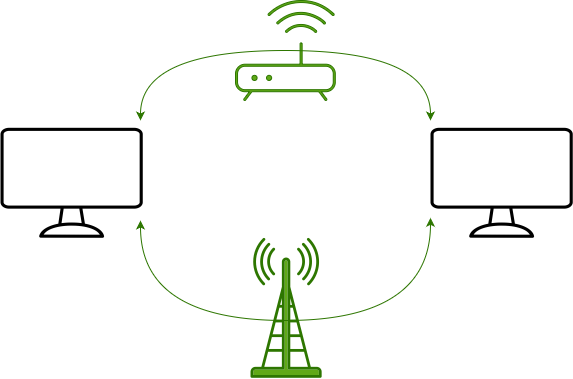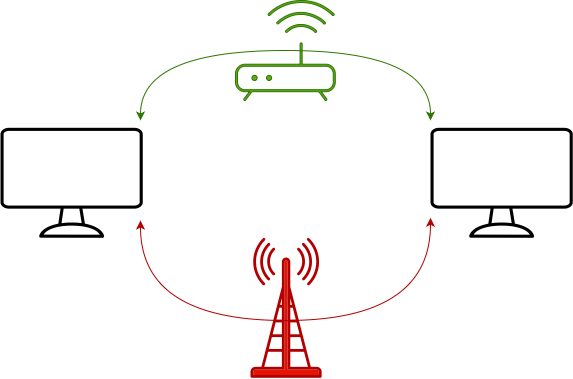Networking for a video call sounds simple. You send your video to the server and server sends video back. But that mental model breaks down in the real world. A connection that starts on stable home Wi-Fi may suddenly need to continue over cellular as someone walks out the door. The real challenge isn’t just connecting two points! It’s staying connected as the network beneath you changes.
With automatic renomination, Pion will now handle that completely seamlessly, allowing your media to flow without skipping a beat. It works by periodically detecting when new connection candidates are available and automatically switching to the highest quality candidate, taking advantage of a feature in WebRTC called renomination.
Let’s dive into how that works.
How does WebRTC establish connections?
Connections between two peers in WebRTC are established by exchanging candidates between the two peers in a signaling phase. These candidates can be host, server reflexive, peer reflexive, or relay candidates. The details of the various types of candidates are better explained in WebRTC for the Curious, but the relevant detail is that for each candidate, both peers open up ports to communicate.

Eventually, the controlling peer picks a candidate and tells the controlled peer to use it in a Binding request. This candidate becomes the selected candidate that media flows over. After this point, the unused ports are closed.

But wait! This handshake is pretty slow. To speed things up and get media flowing faster, WebRTC allows media to flow over any candidate before one is formally nominated. This shaves off a few round trips between the peers, reducing connection latency, in a process called aggressive nomination.
Changing candidates with renomination
Now, what if we never commit a candidate? The ability to send media over any valid candidate is curious, and in fact quite useful because it means we have multiple paths to take advantage of. This is called renomination.
Under renomination, the controlling peer tells the controlled peer that it wants to be able to renominate candidates. When the controlled peer receives a binding request, instead of closing the ports, it leaves them open. This allows the controlling peer to elect a new candidate at will, which the controlled peer will accept media over, effectively enabling us to switch candidates mid-stream.

That can sound complex to negotiate but it amounts to a flag in the connection handshakes that ensures that both parties are aware of the desire to renominate, meaning the implementation of this feature in Pion amounts to keeping track of a counter.
Now Pion is taking advantage of WebRTC’s aggressive nomination state, keeping candidates open, and has the ability to pick a new candidate.
Making it automatic
Ideally, the WebRTC connection can do this automatically so the user doesn’t have to pick. After all, manually renominating candidates seems useful but is a tedious user experience. Let’s do it automatically!
To make this work, we need to solve two problems: knowing when the current candidate gets worse, and discovering when completely new candidates appear.
Detecting when candidates get worse: Turns out, this is already built into WebRTC. During the first connection establishment phase, candidates are pinged, evaluated, and ranked based on round trip time, packet loss, and type of candidate. This same ranking can be performed periodically instead of only at initialization. So, the connection can run this on a loop and automatically renominate candidates when the state of the network changes.
Discovering new candidates: What happens when a completely new candidate comes online? For example, if I connect to a wifi network mid-call, the phone receives a completely new IP address.
This, too, is built into WebRTC, in the form of trickle ICE! If trickle ICE is enabled, candidate exchange can continue after the initial connection handshake until the two sides declare that they’ve exhausted the candidate search. Under automatic renomination, we go one step further and disable the exhaustion declaration, periodically checking for new candidates instead. When a new candidate arrives, we use the normal trickle ICE mechanism to exchange it between the two peers.
Putting it all together
And that ends up being enough! In summary, automatic renomination makes the following tweaks:
- Signal renomination between the peers
- Keep all candidate ports open instead of closing them
- Disable trickle ICE termination
- Periodically ping all candidates and rerank them
- Renominate when a better candidate arises
With these pieces in place, Pion can seamlessly transition between different network links. If you want to see it in action, check out this example!
One really nice thing that I personally liked about this feature when implementing it is that it felt like automatic renomination is a clever reading of the specification: it doesn’t need to reinvent a whole new mechanism and RFC.
In fact, one can go one step further and send media over all candidates, because under aggressive nomination they are all valid. This, actually, is connection bonding for free! There are some practical considerations to getting this working well though, but that’s another blog post.